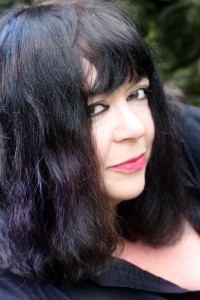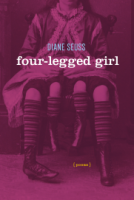
Welcome to “Behind the Byline,” the column in which we share conversations with (and learn so much from) our current NER writers. Poetry editor Rick Barot spoke recently with poet Diane Seuss, author of “Memento Mori,” which appears in NER 36.4.
RB: Compared to most lyric poems we see these days, “Memento Mori” is a fairly long poem. Can you talk about how the poem came about? And, given its length, did it go through many phases of composition and revision?
I wrote the first draft of “Memento Mori” in one sitting while in residency at the MacDowell Colony. I’d been in deep revision mode, working on my next collection, and also feeling mournful as hell. Some of those feelings arise out of the experience of residency itself, at least for me; it’s what makes residencies so important. Alone 20+ hours a day, few distractions, ensconced in the natural world. Unfamiliar twin bed and unfamiliar silence, darkness. Where can the mind go but to the shadowy places? At MacDowell, in New England, I felt a less personal sorrow, a grief that seemed historical, oozing from the ground itself. The only road trip I took was to Emily Dickinson’s house in Amherst, where I felt such grief for her, especially at her grave, which was scattered with offerings—a few wild cherries, someone’s chopped-off hair, coins, sea glass. As smarmy as it sounds, I recited “After great pain a formal feeling comes” from memory with my fingers on her headstone. Driving back from Amherst to MacDowell I began to brew up “Memento Mori.” Although I’ve written many poems about death—who hasn’t?—I’m not sure I’d given myself the license to address it with as much frontal exposure as I decided to do in this poem. “All my life I’ve been writing of it but not from it,” the poem begins, and that was the phrase that set me off. What would it be to write from death rather than to witness it as an onlooker? I’d been studying early still life painting for a big sequence on the subject, and had looked at the genre of vanitas still lives from the sixteenth and seventeenth centuries. These were paintings littered with skulls, hourglasses, smoke, and other references to death which were to be reminders to the viewer that life without an awareness of death is empty—vanity—that we must remember, always, that we will die. Cheery stuff, but useful for my examination of the purpose of art in relation to gender, life, and death.
For me, an exploration of death begins and ends with my father, whose dying is iconic to me because I was so young when it happened. When the poem transitioned from a statement about the gifts I have received from death to “I saw my father/carried from the couch into the waiting ambulance, / which wailed like my mother could not,” I felt a moment of trepidation about going there once more, but decided to follow the poem’s own trajectory and to let it lead me into the briar patch, the subject that’s fed and nettled me from the days I was still in the single digits. I also gave myself space—wide-lines—and put no pressure on myself to compress the poem beyond the natural compression of couplets. It became a kind of essay with line breaks, maybe, a meditation that required more space than the lyric standard. I had no idea where it was going; I rarely know. It felt important to look closely at the literal scene, and to consider possibilities I’d never allowed myself to consider before, such as: what if I’d been there when he died? What if I’d been the one to shut down his eyes? What did I notice when I looked at his body? (“His illness made me conscious of the veins beneath the skin, / the blue of a bruise and its gold aura . . .”) What new language (“throb,” “histiocytosis x”) did his dying give me? I felt that maybe I’d earned the right to really look, as a new parent earns the right to count the fingers and toes of her infant after a long labor. Or if I hadn’t earned it, I was going to do it anyway.
I continued to follow the poem’s connections, and didn’t realize how big it had become until I neared what felt like a conclusion. I was surprised by the turn it took: “he was a sailor in his dying, / an archetype, not a family man” to “Have you traveled, in your wanderings, / to the Chapel of Bones in Portugal . . .” which seemed like a whole other kettle of fish. That turn was crucial to fulfilling the poem’s destiny. I’d made a bone chapel without realizing it. After that first draft the poem was all there. I knew its working parts, and they’ve stayed pretty much in place. I did deep line editing, though, sending it through ten drafts or so of tweaking images and transitions.
RB: Your gorgeous book of poems, Four-Legged Girl, was recently published. Many of the poems seem invested in autobiographical material—some might even say the poems are in a kind of “confessional” mode. How would you describe your relationship to the “confessional” and all the baggage that’s usually attached to that term?
Thank you for reading and mentioning Four-Legged Girl. In response to the confessional baggage, personal history is still history, personal mythology is still myth. When Plath wrote “Daddy” it was fueled, maybe, by her feelings about her own personal father, but its engine, its largesse, arose from her dismantling of The Fathers. Poems, most anyway, have content—we must look somewhere—and in my cosmology, all somewheres are relatively equal, whether public, private, interior, exterior, sky, earth, cityscape or silo. The poems of Four-Legged Girl have antecedents in common with my own experience, certainly, in that my image sack contains those narratives and objects I’ve gathered along the way of living my life in a female body, a Midwestern body, a white body, a small town, working poor, single mother body. Yet, the poems’ speaker is younger, campier, lusher, and less dimensional than I am. The book has the tone and structure of a picaresque, and like a picaresque, its antihero is an invention who serves my purposes. This is not memoir, though there are violets, and I once noticed violets as I was walking my dog in the spring. I’ve never spied on a four-legged girl, though I wish I had.
about her own personal father, but its engine, its largesse, arose from her dismantling of The Fathers. Poems, most anyway, have content—we must look somewhere—and in my cosmology, all somewheres are relatively equal, whether public, private, interior, exterior, sky, earth, cityscape or silo. The poems of Four-Legged Girl have antecedents in common with my own experience, certainly, in that my image sack contains those narratives and objects I’ve gathered along the way of living my life in a female body, a Midwestern body, a white body, a small town, working poor, single mother body. Yet, the poems’ speaker is younger, campier, lusher, and less dimensional than I am. The book has the tone and structure of a picaresque, and like a picaresque, its antihero is an invention who serves my purposes. This is not memoir, though there are violets, and I once noticed violets as I was walking my dog in the spring. I’ve never spied on a four-legged girl, though I wish I had.
RB: From what I’ve seen of your most recent poems, many use the ekphrastic as the starting point. In fact, your next book of poems is titled Still Life with Two Dead Peacocks and a Girl. Can you talk about what drew you to the ekphrastic and how your next book plays with that lyric mode?
Yes, my next book is framed by visual art, specifically early still life painting. I was an art history minor in college, and always very moved by the visual realm. When I was in high school my best friend and I would take the South Shore into Chicago from our hometown on the border of Michigan and Indiana. We’d spend hours at the Art Institute before heading back in the evening. We had no intellectual groundwork from which to see, which might have been for the best. My friend died young, of AIDS, still talking to me on the phone about Rothko, even through the fog of what was ravaging him. The focus on still life came to me in a dream, weirdly enough. I woke up with the words “still life” in my head, with no context or previous interest in that genre to justify it. I did a little research, and suddenly found myself obsessed, working on a series of unrhymed sonnets focused on individual paintings. What I learned in my reading, especially from a fabulous book by Norman Bryson, Looking at the Overlooked: Four Essays on Still Life Painting, was how still life was viewed as the lowest rung in terms of subject matter, offering neither the grand romance of history nor the elevation of gods and cherubs, but simply bowls, peaches, the carcass in the kitchen on its way to becoming food. The realm of women’s work, in other words. This led me to an interrogation of other questions about Art. Who holds the brush and who is the subject? How does the subject escape the frame? What is the relationship between art and the peasant class, the working class, and what have been the consequences for my people? How is art like Eden—a sort of gated paradise from which I must escape in order to return to my people? Writing these poems has been Edenic in itself. The process involved everything I have: intellect, memory and collective memory, consciousness, looking, and feeling. Maybe I was the priest receiving Art’s confession, at least the fragment of its confession that was meant for me.
RB: Who are you passionately reading and re-reading these days? And, in light of your recent ekphrastic poems, are there visual artists you’ve been looking at lately?
I am currently looking closely at photography because I am veering in that direction for my next project. I’m reading Roland Barthes’ Camera Lucida: Reflections on Photography and Mythologies, and re-reading Sontag’s On Photography and Regarding the Pain of Others. I’ll also be considering Primitive Photography: A Guide to Making Cameras, Lenses, and Calotypes, as the process of early photographic invention may come into this new work. The questions rattling inside me are around nostalgia, addiction, and the image.
In terms of poetry, I read all the new work I can. I’m currently teaching Eduardo Corral, Saeed Jones, Evie Shockley, and Natalie Diaz, among others. The cadences of Ellen Bryant Voigt’s Headwaters have become important for me to re-experience, as well as the form and approach of Claudia Rankine’s Citizen. I am interested in the way Matthea Harvey integrates visual images into her most recent collection, If The Tabloids Are True What Are You? I adore Patricia Lockwood’s Balloon Pop Outlaw Black, how unlike anything else it is, how she manages tone and story while engaged in a really serious investigation into the mass-produced image. Bruce Lack’s Service, which emerges from his tours of duty as a Marine in Iraq, is an argument against those who think gimmickry is poetry. Anne Cecilia Holmes’ first book, The Jitters, is so fresh in its approach to the jittery reality of contemporary America. Margaree Little’s book Rest, which is forthcoming from Four Way Books, and Gail Wronsky’s new manuscript Pastoral Imperfect, which takes as its lift-off point The Georgics by Virgil, are keeping me up nights. Always Dickinson.